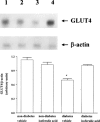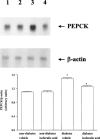Antihyperglycemic action of isoferulic acid in streptozotocin-induced diabetic rats
- PMID: 10683186
- PMCID: PMC1571880
- DOI: 10.1038/sj.bjp.0703082
Antihyperglycemic action of isoferulic acid in streptozotocin-induced diabetic rats
Abstract
Wistar rats with streptozotocin-induced diabetes (STZ-diabetic rats), which is similar to human insulin-dependent diabetic mellitus (IDDM), were employed to investigate the antihyperglycemic action of isoferulic acid. A single intravenous injection of isoferulic acid decreased the plasma glucose in a dose-dependent manner in the STZ-diabetic rats. Repeated intravenous administration of STZ-diabetic rats with isoferulic acid (5.0 mg kg(-1)) also resulted in the lowering of plasma glucose after one day. Stimulatory effects of isoferulic acid on the glucose uptake and glycogen synthesis in soleus muscles isolated from STZ-diabetic rats were also obtained indicating an increase of glucose utilization following isoferulic acid treatment which was not dependent on insulin. The mRNA level of glucose transporter subtype 4 form (GLUT4) in soleus muscle was raised by isoferulic acid after repeated treatment for 1 day in STZ-diabetic rats. Similar repeated treatment with isoferulic acid reversed the elevated mRNA level of phosphoenolpyruvate carboxykinase (PEPCK) in liver of STZ-diabetic rats to the normal level. However, expression of GLUT4 and PEPCK genes in nondiabetic rats were not influenced by similar treatment with isoferulic acid. These results suggest that isoferulic acid can inhibit hepatic gluconeogenesis and/or increase the glucose utilization in peripheral tissue to lower plasma glucose in diabetic rats lacking insulin.
Figures



Similar articles
-
Mechanism for blockade of angiotensin subtype 1 receptors to lower plasma glucose in streptozotocin-induced diabetic rats.Diabetes Obes Metab. 2007 Jan;9(1):39-49. doi: 10.1111/j.1463-1326.2005.00566.x. Diabetes Obes Metab. 2007. PMID: 17199717
-
Antihyperglycemic effect of puerarin in streptozotocin-induced diabetic rats.J Nat Prod. 2003 Jun;66(6):788-92. doi: 10.1021/np0203887. J Nat Prod. 2003. PMID: 12828463
-
Antihyperglycemic action of angiotensin II receptor antagonist, valsartan, in streptozotocin-induced diabetic rats.J Hypertens. 2003 Apr;21(4):761-9. doi: 10.1097/00004872-200304000-00020. J Hypertens. 2003. PMID: 12658023
-
Antidiabetic Properties of Chitosan and Its Derivatives.Mar Drugs. 2022 Dec 17;20(12):784. doi: 10.3390/md20120784. Mar Drugs. 2022. PMID: 36547931 Free PMC article. Review.
-
Neurological changes induced by stress in streptozotocin diabetic rats.Ann N Y Acad Sci. 1999;893:126-37. doi: 10.1111/j.1749-6632.1999.tb07822.x. Ann N Y Acad Sci. 1999. PMID: 10672234 Review.
Cited by
-
Isoferulic acid, a new anti-glycation agent, inhibits fructose- and glucose-mediated protein glycation in vitro.Molecules. 2013 May 30;18(6):6439-54. doi: 10.3390/molecules18066439. Molecules. 2013. PMID: 23722732 Free PMC article.
-
Metabolomics and Ionomics of Potato Tuber Reveals an Influence of Cultivar and Market Class on Human Nutrients and Bioactive Compounds.Front Nutr. 2018 May 23;5:36. doi: 10.3389/fnut.2018.00036. eCollection 2018. Front Nutr. 2018. PMID: 29876353 Free PMC article.
-
A Review of the Potential Consequences of Pearl Millet (Pennisetum glaucum) for Diabetes Mellitus and Other Biomedical Applications.Nutrients. 2022 Jul 18;14(14):2932. doi: 10.3390/nu14142932. Nutrients. 2022. PMID: 35889889 Free PMC article. Review.
-
Isoferulic acid prevents methylglyoxal-induced protein glycation and DNA damage by free radical scavenging activity.BMC Complement Altern Med. 2015 Oct 5;15:346. doi: 10.1186/s12906-015-0874-2. BMC Complement Altern Med. 2015. PMID: 26438049 Free PMC article.
-
Chlorogenic acid stimulates glucose transport in skeletal muscle via AMPK activation: a contributor to the beneficial effects of coffee on diabetes.PLoS One. 2012;7(3):e32718. doi: 10.1371/journal.pone.0032718. Epub 2012 Mar 7. PLoS One. 2012. PMID: 22412912 Free PMC article.
References
-
- BAQUE S., MONTELL E., CAMPS M., GUINOVART J.J., ZORZANO A., GOMEZ-FOIX A.M. Overexpression of glycogen phosphorylase increases GLUT4 expression and glucose transport in cultured skeletal human muscle. Diabetes. 1998;47:1185–1192. - PubMed
-
- BARON A.D., BRECHTEL G., WALLACE P., EDELMAN S.V. Rates and tissue sites of non-insulin-and insulin-mediated glucose uptake in human. Am. J. Physiol. 1988;255:E769–E774. - PubMed
-
- CHALLIS R.A.J., LEIGHTON B., WILSON S., THURLBY P.L., ARCH J.R.S. An investigation of the β-adrenoceptor that mediates metabolic responses to the novel agonist BRL 28410 in rat soleus muscle. Biochem. Pharmacol. 1988;37:947–950. - PubMed
-
- CHANG C.J., KAO J.T., LEE T.L., LAI C.W., CHENG J.T. Comparison of isoproterenol with BRL37344 in activation of beta 3-adrenoceptors to inhibit the uptake of [14C]-deoxy-D-glucose and translocation of glucose transport (GLUT4) to membrane fraction in rat adipocytes. J. Auton. Nerv. Syst. 1996;61:191–194. - PubMed
-
- FORMAN L.J., ESTILOW S., MEAD J., VASILENKO P. Eight weeks of streptozotocin-induced diabetes influences the effects of cold stress on immunoreactive beta-endorphin levels in female rats. Horm. Metabol. Res. 1988;20:555–558. - PubMed
Publication types
MeSH terms
Substances
LinkOut - more resources
Full Text Sources
Other Literature Sources
Medical

